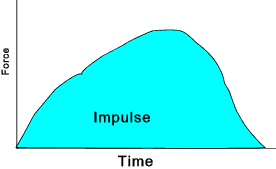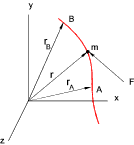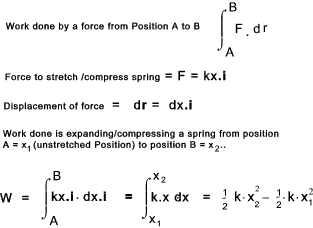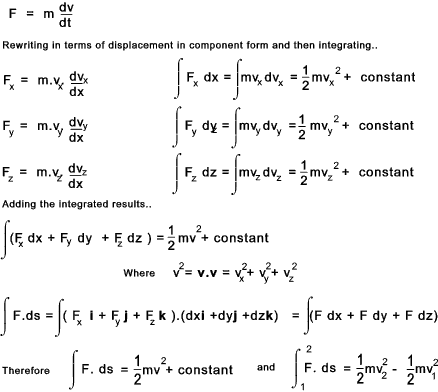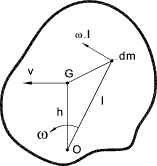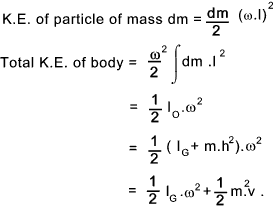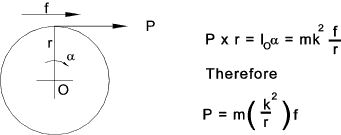| |
Mechanics Index
Dynamics / Kinetics
|
Introduction The contents of this page are listed below Basics. Definitions..
It is assumed that all motions are within the plane and rotations are around axes perpendicular to the plane. Infinitesimal counterclockwise rotations are positive and are therefore represented by vectors perpendicular to the plane as indicated by the right hand rule- If the plane is the x-y plane then angular velocities are in the positive z direction. It should be noted that large rotations and angular velocities do not follow vector rules.. Free Body Diagram A free body diagram is an extremely useful tool for assessing the interaction of forces on bodies
This is essentially a sketch of a body which is in equilibrium
and is entirely separate from the surroundings. The only rule for drawing
free-body diagrams is to depict all the forces which exist for that object in the
given situation. Particle Kinetics. Newtons laws Newtons First Law;
Newtons Second law;
Newtons Third law
The momentum is defined simply as the product of mass and velocity..The first law states that if a body changes its velocity then a force must have been applied. The second law establishes a relationship between the magnitude of the force and the change in momentum.. Force = k. d(momentum)/dt = k.d(mv)/dt = k.m dv/dt = k.m. a In the metric ISO system the unit of force of 1 Newton (N) on a mass of 1 kg results in a linear acceleration of 1 m/s 2 therefore k = 1.
m 1. u 1 + m 2. u 2 = m 1. v 1 + m 2. v 2 ... therefore m 1 . ( v 1 - u 1 ) = m 2( v 2 - u 2 ) Equations of Motion for a particle under different force regimes
1) Force = constant value.. F = C= constant = mass x acceleration.. m. dv/dt = C Falling masses under the effect of gravity provides an example of this condition m.dv/dt = F(t)
Using F(t) the equation for the velocity can be determined by integration, and again the displacement
can be found from ds = vdt. m. dv/dt = F(v)
Example: The resistance to motion of drag or viscous damping when the force = C x velocity where c = the damping coefficient.. m. dv/dt = F(s)
Example : The force developed by spring = k x s where k is the stiffness of the spring. Circular motion .. A mass rotating in a circle is accelerating towards the centre of the circle at a rate
of acceleration of v2 /r. The force pulling the body into the centre of the circle
is the centripetal force. (if the mass is spinning on a string the centripetal force is the tension
in the string). The reaction force at the centre of the circle is the centrifugal force.
There is no force pulling outwards on the circling body there is only a force pulling in Rigid Body Kinetics.
Considerations of rigid objects are simplified if ...
The moment of Inertia of a particle of mass dm at a radius r from a axis through the centre of gravity G is dm.r 2. The moment of inertia of the whole body about the axis through G = This is generally written as
Where k is termed the radius of gyration.
T= applied torque and α = angular acceleration.. Impact- Impulse The relationship between force and the motion of a mass as shown above can be written as..
This can be integrated to..
Impulse = change in momentum The impulse is effectively the area under a plot of the force-time relationship
The angular impulse of a constant torque T acting over a time t is the product of Tt. (If the torque varies
the angular impulse is the integral or the area under plot of Torque-time relationship. )
That is the impulse of torque = change in angular momentum.. Work Energy and Power Work The transfer of energy expressed as the product of a force and the distance through which its point
of application moves in the direction of the force.
...
It should be noted that work only results if the point of application of the force moves. There is no work done
if a weight is supported without movement.
If a force is acting on a particle as it move from A to B . The work done as the particle
moves a small distance dr = F. dr . The work done is the product of the Force vector
and the displacement vector. Only the force component in line with the displacement component contributes
to the work done. Work is a scalar quantity and is measured in N.m (ISO units)
The work performed by a force F (N) when the point of application moves S (m) with angle q between the force and the direction of motion . Work (U) = F.cosθ .S The work performed by a couple M turning an object through an angle θ is Work (U) = Mθ Work is a scalar quantity..
Conservative Forces
If the work done by a force is independent of the path the force is called a Conservative force. Examples
of conservative forces include spring forces and gravitational forces. Conservative forces are generally recoverable
; that is if work is done in lifting an object against gravity through a vertical height h
, the work is is recovered
by lowering the weight back to the original level. When force is required to move an object to overcome friction the energy dissipated
cannot be conveniently recovered as work The work done against friction is not available
as kinetic or potential energy. The work done by a non-conservative force is dependent on the path taken by the point of
application of the force.. Energy At its simplest level energy is defined as the ability to do work. Energy takes many
forms including kinetic energy, potential energy, thermal energy, chemical energy, electrical energy, and atomic energy. The field of mechanics includes kinetic energy which is energy possessed by a body due to its motion and potential energy
which is energy possessed by a body because of its position in a field force (gravity /elastic force).
The term m.v 2 / 2 is called the kinetic energy of the mass and hence the derivation above results in Work Done by a force on a mass = change in kinetic energy. Angular kinetic energy ..
A body is rotating about and axis through O.
If the centre of gravity of a body is moving with a velocity v and is rotating with and angular velocity of w about the centre of gravity. The total K.E. = K.E. of translation + K.E. of rotation
When considering motions of machines with comprising masses in linear motion and masses with and angular motions it is often required to find the equivalent mass of a rotating body. This occurs often with vehicle dynamics. In considering a body of mass ( m ) rotating about an axis through O with a tangential force at radius ( r ) producing a linear accelaration at this point of ( f ) with and a resulting angular accelaration of (α ).
The quantity m.( k / r ) 2 is the equivalent mass of the
body referred to the line of action of P. In general terms potential energy identifies some form of stored energy which can be converted
into some other form of energy. Potential energy take many forms including mechanical, chemical,
electrical nuclear etc. These notes only consider mechanical potential energy which is energy
stored by a body because of its position with respect to a datum is a conservative force field.
The two most common forms of potential energy in mechanical engineering are gravitational potential energy
and elastic strain energy.. FG = m.g
where g = the gravitional constant (acceleration due to the attraction of the earth) ..This is generally approximated to 9.81 m/s2 but can vary
at due to variations resulting due the fact that the earth is not a perfect even sphere and due to the
effect of other celestial bodies. PE = g.m (h2 -h2 )
An example of the elastic strain potential energy is the extension or compression
of a spring as noted above.. The principle of conservation of energy in it simplest form states
Power Power is defined as the rate of doing work. Power = P = dW/dt = F. dr /dt = F.v Power is a scalar quantity with units N.m/s |
Links to Dynamics /Kinetics
|
|
Mechanics Index



